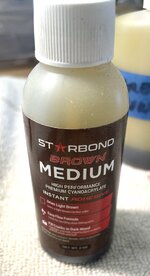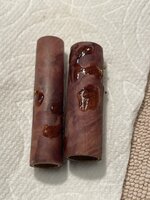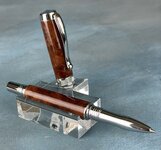mmayo
Member
I just turned a rollerball using mallee (sic) burl wood and discovered, as always, that there were numerous tiny cracks and voids. Since I'd like this pen to be smooth I used Starbond medium CA in brown. I also have Starbond black for other woods. I exclusively use EZ Bond CA for finishing, but I diverge for gap filling. I like the colored stuff better than clear in most cases where it just looks better.
I turn the pen bodies, sand them and clean well with DNA. If needed I use the compressor to blow out the dust. When dry I apply the brown CA to all the cracks I can find. I found one and filled it after the photograph attached to this post. I spray accelerator and let cure quite a while. I carefully turn again, sand, clean and hope one round of filling gets the job done. It works for me!
Best of luck with your voids.
I turn the pen bodies, sand them and clean well with DNA. If needed I use the compressor to blow out the dust. When dry I apply the brown CA to all the cracks I can find. I found one and filled it after the photograph attached to this post. I spray accelerator and let cure quite a while. I carefully turn again, sand, clean and hope one round of filling gets the job done. It works for me!
Best of luck with your voids.



